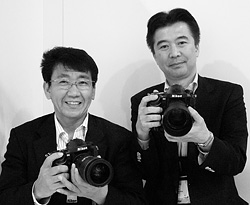Nikon interview: CIPA tests hide the D4’s improved battery life
posted Wednesday, January 18, 2012 at 12:54 AM EST
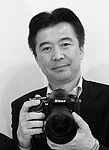 In our time with Nikon's Toshiaki Akagi at CES 2012, we found our wide range of questions would be limited to the Nikon D4, so we turned it into another question and answer session while we had access to the General Manager of Design, using many questions from Twitter and a few left over from our Live Q&A earlier in the week. Also included in the meeting were Kenji Suzuki, who served as Mr. Akagi's translator, Yasuhiro Nozaki, Planning Manager, Lindsay Silverman of Nikon USA, plus Dave Etchells, Arthur Etchells, and Shawn Barnett.
In our time with Nikon's Toshiaki Akagi at CES 2012, we found our wide range of questions would be limited to the Nikon D4, so we turned it into another question and answer session while we had access to the General Manager of Design, using many questions from Twitter and a few left over from our Live Q&A earlier in the week. Also included in the meeting were Kenji Suzuki, who served as Mr. Akagi's translator, Yasuhiro Nozaki, Planning Manager, Lindsay Silverman of Nikon USA, plus Dave Etchells, Arthur Etchells, and Shawn Barnett.
Dave Etchells, Publisher, Imaging Resource:
We heard about the terrible misfortune in Thailand with the flooding, and we know that had an impact on Nikon. Can you tell us anything about the flood recovery, what progress you're making, and when you might be back to full production?
Toshiaki Akagi, General Manager, 1st Designing Department, Development Headquarters, Imaging Company, Nikon Corporation (translated by Kenji Suzuki, Technical and Engineering Liaison, Nikon Inc.):
We are trying to recover from the Thailand issue, and we will probably be back up and running at 100% capacity in March or April. A number of parts for the D4 are made in Thailand, including the D4 shutter unit, but now we will make the shutter unit in Japan.
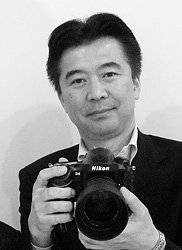 DE: We have a reader question: The D5100 and now the D4 do HDR mode, taking multiple shots; does the camera do any alignment of images, or do you have to mount the camera on a tripod?
DE: We have a reader question: The D5100 and now the D4 do HDR mode, taking multiple shots; does the camera do any alignment of images, or do you have to mount the camera on a tripod?
Lindsay Silverman, Nikon USA:
We recommend the use of a tripod with any of the HDR features in the camera, whether it's the D5100 or the D4.
DE: So it's not doing any alignment of the images?
LS: No, it's not. It does not align, and we recommend using a tripod in our instruction manuals for both cameras to get the maximum performance from HDR. That doesn't mean you can't handhold it, as I do all the time.
In the D5100, when you shoot an HDR sequence and you want to shoot another sequence, you have to go back into custom settings. With D4, there's a setting that allows you to take a series of HDR shots, so you don't have to keep going back and forth to custom settings. Also, I have noticed -- because I shoot HDR a lot -- that the D4 with EXPEED 3 is very, very fast at processing HDR. In fact, you can shoot a sequence, and then literally take your finger off the shutter release, and then come back down and the camera is ready to shoot. So the processing time on D4 is faster than on the D5100.
DE: Another reader question: The D4 can send its video feed through HDMI instead of to a memory card. In that mode, will it record for longer than 20 minutes, or is there a limit because of sensor heating?
TA: If we use HDMI output, we can capture a long movie, over 30 minutes. But there is an issue with sensor heating, so if the temperature sensor detects overheating, the camera will turn off.
LS: It will power down by itself at about 60 minutes. It starts to count backwards. It's a 30 second countdown, 30 - 29 - 28, to tell you when the camera will power down. It might take a few seconds for it to cool down before you can reactivate it again.
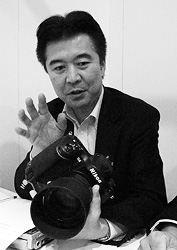 Arthur Etchells, Features Editor, Imaging Resource:
Arthur Etchells, Features Editor, Imaging Resource:
Do you know what that period is?
LS: It's brief. I don't know the exact time, but it is brief.
AE: And then you'd be able to do another 60 minutes?
LS: Yes. It also depends on external factors, like heat. So if you're in a hot environment, not only is it the sensor's heat, but it's the hot environment that will cause that as well, so both are considerations.
AE: In looking at the connectivity, there's a wealth of different ports on the Nikon D4, one of those is the LAN. Looking at the spec for that, how did you decide on 100Mbps as opposed to gigabit LAN?
TA: We kept considering power consumption and heat. If we used gigabit LAN we would have a heat problem, and greater power consumption. So we chose 100Mbps LAN.
DE: We're curious about video modes, and the time of recording. In 24p mode, the spec says you can record for 20 minutes, but in 30p, you can record for almost 30. That seemed odd to us; we thought faster would mean shorter time.
TA: We think these specifications are incorrect. Both 24p and 30p are capable of recording 29 minutes, 59 seconds.
DE: The D4 does 1080p at 30 frames per second, will it possibly in the future do 60 frames per second? Is there any possibility of upgrading the firmware?
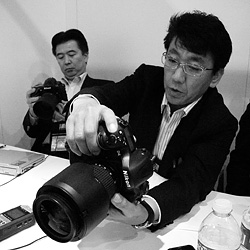 TA: 60 frames per second, p or i?
TA: 60 frames per second, p or i?
DE: I think they're asking p.
TA: 1080p 60? No.
DE: It's a hardware limit?
TA: Yes.
DE: Another question people are curious about: why two different memory cards? Why not two the same, instead of CF and XQD?
TA: CompactFlash is technically limited in terms of speed, so our company and Sony constructed a new technology because we needed a faster card, so we made the XQD card. But [building the D4 with] two XQD cards is a little risky, so we chose to use Compact Flash and XQD.
DE: So XQD has a better spec, but you put a CompactFlash in because there's so much CompactFlash already in the market?
LS: To put two XQD cards at this time, which is a newly developed card system, would be a risk because they weren't sure if XQD would be available when the camera shipped. So the decision was to offer one slot with the CF card standard, which photographers already have, and to offer the newer XQD as well.
AE: Which of those cards ends up being a constraint, or a potential constraint in bandwidth or buffer pool?
TA: XQD card is faster than CF, by almost 30%.
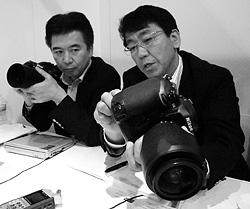 Yasuhiro Nozaki, Planning Manager, Nikon Inc.:
Yasuhiro Nozaki, Planning Manager, Nikon Inc.:
30% faster is the current status. You know, the new card has much more potential, so for the future, maybe 50% faster than the CF card.
DE: We had a meeting with Lexar yesterday and they said they have a 1,000X CF card now, it's 150 megabytes per second. They said that's faster than the current XQD, but that's really the limit of the CF format.
LS: Right, because our current XQD runs at 125 megabytes per second, but the next generation will be faster.
DE: The D4 battery has lower capacity. We understand that was because of a Japanese regulation. One question about that is, is that a limitation on strictly milliampere hours, or is it on total power, combination of voltage and milliamp?
DE: We're trying to figure out how Canon got away with 2,450 milliamps in the 1D X.
TA: The reason we changed the battery is because of the Japanese standard, we have to change it to keep to the Japanese standard. Tested to the CIPA standard, this model can take about 2,600 pictures, a slight decrease compared with the D3S battery. But in the case of a professional photographer shooting continuously, this battery can take more pictures than the D3S.
DE: So you're saying that for an actual, professional photographer, burst shooting, the D4 will take more pictures than the D3S?
LS: Dave also said that he noticed that Canon's 1D X battery was 2,450 milliamp. How was Canon able to come up with a battery with a higher milliamp?
YN: The character of the battery is different as compared with Canon's new battery. This one is much more powerful than our old battery, so we created this battery in order to have the best performance with this one, or other old model. When you make a burst shutter, it requires much more power... but based on the old battery, sometimes performance is not good. When you use this one, it's much better performance.
DE: So it can deliver more current in bursts than the old battery?
YN: When the temperature is cold, the performance of the D3S battery is not stable. But the new Nikon D4 battery is much more stable. That is another unique point for the new battery.
AE: The appeal of the D4 is undeniable for videographers. What would you say are the top features, and what is the appeal of the Nikon D4 for still photographers?
LS: From an outward appearance, the camera has been refined so that, while working all day holding a camera, the camera is much more comfortable to hold than the D3S. So, the controls, the layout -- although it doesn't look much different, is slightly different, but in a very, very good way that makes it much more comfortable to hold, and controls are much easier to get at.
As for the inward technology improvements: Now, you would say that a nine frame-per-second rate in the D3, versus 10 frame in the D4 is not a big improvement, but in fact it really is a big improvement. That was done in several ways: by updating the sensor technology of the autofocus, the Multi-CAM 3500, and also the inclusion of the 91,000 pixel RGB sensor, which allows D4 to focus-track in a much more fluid manner. So instead of the 1,005 pixel RGB of D3S where I lock in on Akagi-san's face, and he's running, I say "focus-track, color, gap, gap, gap, gap, gap, color; gap, gap, gap, gap, color" on this particular array, we have 91,000 RGB, so it's now "color, color, color, color, color, color, color, color, color." So the focusing is much smoother, and much more fluid, and in fact, more accurate with those high-speed bursts.
Also, because of that 91,000-pixel RGB sensor, auto-white balance has improved, iTTL flash has improved, auto-exposure has improved, so for a still photographer who makes a living on decisive moments, you have a camera that will respond quicker, and give you more accurate exposures, in more varieties of light, thanks again to the wide ISO range on the camera.
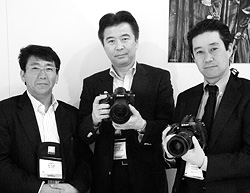 So very, very critical for this photographer -- that one frame per second is a very critical specification for shooting sports or even just decisive moments of a wedding photographer, where the bride might turn and look to her dad, and that's one of those very private moments that only happens -- (snaps fingers) -- like that, so as you turn and shoot that burst capacity, it's very, very critical to how a photographer makes a picture. So those improvements go hand-in-hand for still photographers.
So very, very critical for this photographer -- that one frame per second is a very critical specification for shooting sports or even just decisive moments of a wedding photographer, where the bride might turn and look to her dad, and that's one of those very private moments that only happens -- (snaps fingers) -- like that, so as you turn and shoot that burst capacity, it's very, very critical to how a photographer makes a picture. So those improvements go hand-in-hand for still photographers.
And then of course, the new sensor. While photographers are very smart, and they understand in some cases that D3S at 12 megapixel had great image quality and had great high ISO performance. So this new sensor, this new 16.3-megapixel sensor, was chosen because of its balance between image quality, high ISO performance and burst rate, so that the camera can do all that. So it's a carefully choreographed balance of how well these features work together. I think you really can't overlook the ergonomics of the camera, because that's... you're working six, seven, eight hours a day holding a camera, it's got to be comfortable in the hands; it's got to be fluid to work. I believe they have achieved that in a very, very big way with the camera.
AE: Looking at the buttons and controls for the metering and focus area, what was the decision process to deciding how much space to devote to those?
LS: Why did Nikon put the sub-selectors here and changed the live view to still and video, and focusing?
TA: The professional photographer changes between vertical and horizontal positions very often. In both positions, they'll find most controls in the same place. And photographers often change the autofocus area, so we made this sub-selector joystick. And we moved the vertical AF-On button so that it appears in almost the same position.
DE: So, a lot of it was that the fact that you saw that professional photographers changed from horizontal to vertical very frequently, and you wanted to position buttons so that they're in the same places for both grips.
TA: And Live view. In the D3 and D3S, the live view setting, we used this setting...
DE: By rotating under the Drive Mode dial. Yes.
TA: So we wanted to make it easier to use Live view and Movie mode, so we made a new control for both. Very easy positioning.
YN: This was from customer feedback... It's not easy to use when located here on the Drive Mode dial, but in the new position, it's much easier to handle.
LS: The voice of the customer is very, very important for all of our products, whether it be Coolpix, or Nikon 1, or DSLR, as you know. But on the professional community side, through our NPS activities around the world, we know a lot of photographers, so we welcome that kind of feedback, and for many years that feedback has always been provided, and so then we take a careful look at what photographers have been saying who use the cameras on a daily basis, and then they decide again, I guess it's a balance of where you can change the controls, and how you can improve it.
DE: There's some confusion over support for the older flash units, the SB-600 and SB-800, the specs indicate that the flash ready indicator shows up when one of the newer units is attached, SB-910, 900, 700; but they don't mention SB-600 and 800. Is the camera fully compatible with 600 and 800?
LS: Yes.
DE: So that's just an omission in specs? It doesn't mean it won't show flash ready?
LS: Yes, I would think it's a case of, you can't just keep listing products and specifications over and over and over again. But, I believe it works fine... SB-800? SB-800 should work fine -- specific to ready light indicator? Can we check on that, and give you an answer on that later? Rather than try to guess what the reason is, or if it's even accurate information? I can check on that, I know what to check on. I'm not sure if that's accurate, or if the specification actually did change.
Shawn Barnett, Senior Editor, Imaging Resource:
Also, did they drop the Lock button altogether?
LS: No, the Lock button is now in the menu system, so you can lock shutter speed and aperture through the custom settings.
DE: There are also some questions about the WT-5 WiFi transmitter. How much power does that draw from the battery? How does that affect battery life?
TA: That depends on the conditions. It's hard to define.
DE: We had a number of readers, also, asking about GPS, and why you can attach a GPS receiver, but people are saying why wasn't GPS built into the camera?
TA: We always have a GP-1 GPS accessory, then we want to use a GP-1, and if we include a GPS function in the camera, the camera would be bigger. And GPS still has a little problem, so for example indoors, we cannot get GPS data, then we are considering now to adapt the GPS to the next model, in the future. While you are indoors, the performance is not stable, so that's why we gave up to install the function in the body as of now.
DE: Because GPS keeps getting better, so rather than locking it into the body...
YN: The technology is growing. Later we might have the function in the body.
DE: So this was, as GPS gets better, you can make a GPS-2, and then all the cameras are upgraded, all the cameras have that better capability.
SB: What kind of improvements do you see coming to GPS? Is it the local cell towers, the local GPS enhancement for in-building location?
TA: We are studying now, every day. (laughs)
DE: That's all we have time for now. Thank you very much! Good to meet you.
As we mentioned at the outset, we still have more questions than we were able to answer, so we're collecting the various questions from the Q&A and forwarding them to Nikon USA representatives. Watch for a follow-up with as many answers as we can get.
